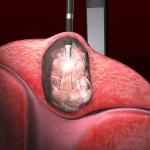
Toya Johnson, the popular We TV reality star, is once again opening up about her personal struggles with fibroids as her vlog series, “A Fibroid Journey”, returns on YouTube. In the latest episode, she realizes her fibroids have returned.
Johnson emphasizes how her previous myomectomy left her with a large incision – similar to her two C-sections. Just when she and her husband are thinking about having another child, she is blind-sighted by the realization that she needs fibroid treatment again.
This candid look into her life both on and behind the camera aims to educate the millions of women facing similar challenges with fertility, fibroids, and pregnancy.
The first episode, “Back in the Fight Again: Fibroids Return” chronicles the turmoil Johnson feels once she realizes she needs to deal with these painful benign tumors, that often impact fertility and pregnancy.
What Fibroids Means for A Future Pregnancy
A concerned Johnson confides to her friend, Danielle, that her husband, Robert “Red” Rushing wants another child:
“I think he’s serious about having another baby. The truth of the matter is I’ve been putting it off, because I really feel like my fibroids are back.”
Unsure on how to reveal her fibroid disease- which is in addition to causing painful menstrual symptoms and heavy bleeding, her friend advises her to talk to the doctor first.
Johnson talks with her GYN, Dr. Jackie, who tells her that pregnancy is too great a risk and advises her to seek fibroid treatment first.
The biggest risks are preterm delivery and fetal growth restriction where the baby does not grow fully due to the fibroids pressing on the uterus. C-section delivery is usually recommended for women who underwent myomectomy surgery.
A tearful Johnson confesses the truth about her fibroids to Red.
“I’m at a very confused place right now. I just don’t know what to do at this moment.”
Life After a Myomectomy: Toya Johnson’s Perspective
“I had fibroids before and I did a myomectomy. It was almost like having a c-section again.”
The ten fibroids that were removed with an abdominal myomectomy left Johnson in severe pain.
“It was like I just gave birth, but I got rid of fibroids. But it was painful, really, really painful because again, you’re getting cut…. you have to get help. It’s like you’re losing four to six weeks of your life. Like, I can’t work, I can’t do things on my own. Like, I need somebody there to help take care of me.”

Fibroid Recurrence After Myomectomy
Fibroid regrowth after a myomectomy can be as high as 60%. Red Rushing expresses his shock to learn that fibroids can reoccur after a myomectomy. Johnson says:
“And it just makes me so upset to know that after going through the whole procedure, staying in the hospital, getting cut on, all of these things, only to know that I have to do something like that all over again.”
New fibroid development can be fueled by a woman’s hormones, especially if she is younger and not near menopause. After a myomectomy, fibroids often regrow in a more aggressive manner.
“It wasn’t recently I found out that how many I had, and how big they were. It’s just been causing so much pain, and I’m so, so tired.”
Uterine fibroids can vary in size from as small as a seed to as large as a grapefruit.
What You Should Know About a Myomectomy
A myomectomy is a surgical procedure performed to remove fibroids while preserving the uterus itself. There are several types of myomectomies. A large incision to remove the fibroids requires a six-week recovery time, like a C-section.
Laparoscopic and hysteroscopic myomectomies are less invasive alternatives to the abdominal approach. Laparoscopic myomectomy involves multiple smaller incisions and a camera. Hysteroscopic myomectomy is performed through the cervix without any abdominal incisions.
Potential complications include:
- Surgical Risks: Like any surgery, myomectomy carries risks such as bleeding, infection, and damage to nearby organs.
- Scar Tissue: Surgery can lead to the formation of scar tissue, which may cause pain or complications during future pregnancies.
- Fibroid Recurrence: There’s a risk of fibroids growing back after surgery, especially in certain cases.
- Recovery Time: The recovery period can be lengthy and may involve pain, fatigue, and limitations on physical activity.
- Potential Impact on Fertility: While myomectomy preserves the uterus, it may affect fertility in some cases.
- Emotional Toll: The physical and emotional stress of surgery and recovery can be significant.
Similarities Between Myomectomy and C-Section Recovery
Both myomectomy and C-sections involve incisions in the abdominal wall and manipulation of the uterus. As a result, both can lead to pain and fatigue.
Additionally, both surgeries require a significant amount of time for the abdominal muscles and uterus to heal, leading to a lengthy recovery period.
Johnson knows this firsthand. Her experience highlights the importance of exploring all treatment options and making informed decisions on one’s health. Johnson shares:
“I know it’s somebody that’s going through what I’m going through that’s tired of doing fibroid surgery. It’s just frustrating.”

Myomectomy and C-Section Delivery
Myomectomy remove uterine fibroids, can lead to a higher rate of c-section deliveries because the incisions made in the uterine wall increase the risk of uterine rupture during labor. Doctors often recommend a planned cesarean delivery as a preventative measure, especially if the fibroids were large or deeply situated within the uterine muscle; this is particularly true when the myomectomy involved deep incisions into the uterine cavity.
Why Exploring UFE Non-Surgical Fibroid Treatment is Important
Johnson, having undergone myomectomy before and dealing with the emotional toll of her fibroids returning, is now exploring her options:
“I have plans to research some different options instead of doing another myomectomy, because I really don’t want to do that again. It’s almost like having a baby again. I’ve been cut a lot of time, and I have a lot of scar tissue. I’m trying to avoid that procedure.”
Johnson talks about exploring uterine fibroid embolization (UFE) which shrinks the fibroids, as an option to avoid the pain and challenges of another invasive surgery. UFE offers a less invasive, faster recovery and uterus-preserving option compared to surgical procedures.
“My doctors’ are running different tests to see what’s good for me, like what I’m a candidate for.”
Miss Part One? Watch on Demand Toya’s Vlog Series: A Fibroid Journey
“A Fibroid Journey” is a project dear to Johnson’s heart because she wants women to understand the emotional and physical toll fibroids can have on life.
In Part One, Johnson reflects on her first diagnosis in 2017, sharing her fears when presented with limited treatment options. After making the decision to have a myomectomy, Johnson recounts the long recovery and pain she experienced after the procedure.
Stay Tuned for the Release of Part Two, Episode Two
Learn more about the benefits UFE offers for fibroid treatment by calling USA Fibroid Centers at 855.615.2555.




